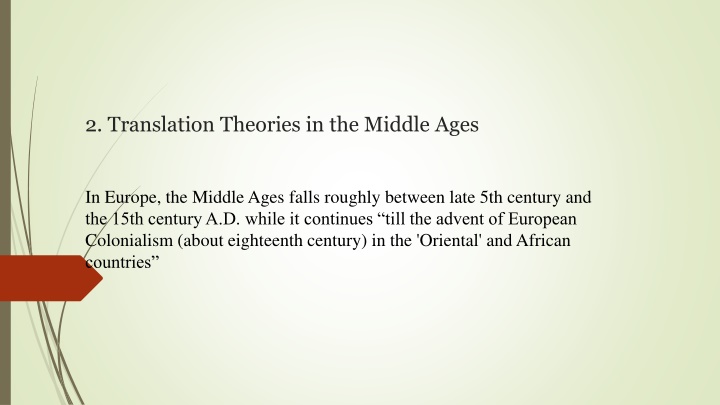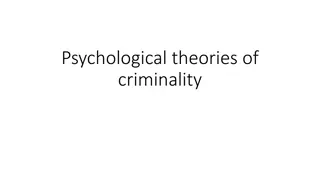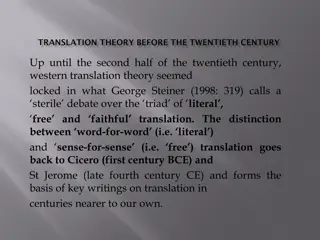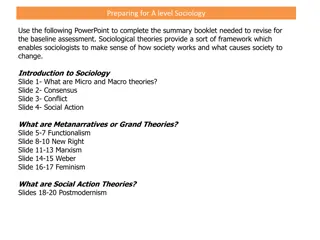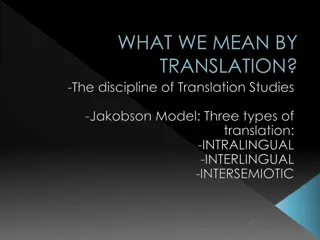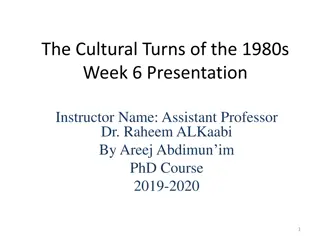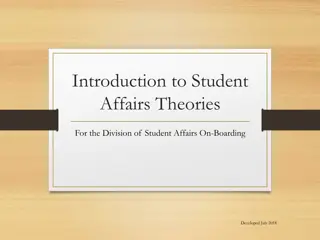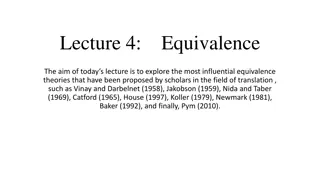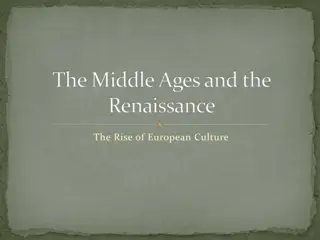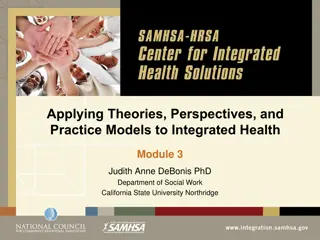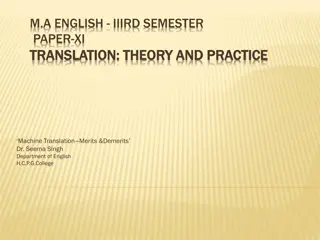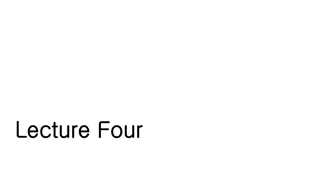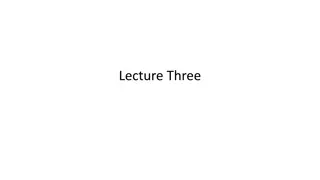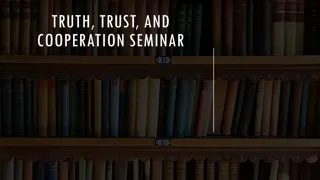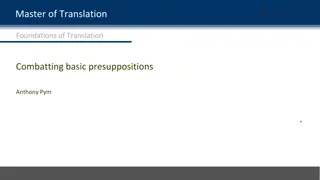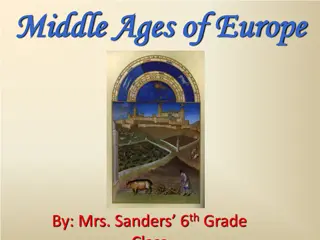Translation Theories in the Middle Ages
In Europe, the Middle Ages spanned from the late 5th to the 15th century AD until the era of European Colonialism. Various translation theories emerged during this period, including word-for-word and sense-for-sense translation methods. Notable figures like John Scotus Eriugena and translators during the Abbasid Period significantly influenced translation practices, bridging linguistic and cultural gaps. This historical account delves into the complexities, challenges, and advancements in translation during the Middle Ages.
Download Presentation

Please find below an Image/Link to download the presentation.
The content on the website is provided AS IS for your information and personal use only. It may not be sold, licensed, or shared on other websites without obtaining consent from the author.If you encounter any issues during the download, it is possible that the publisher has removed the file from their server.
You are allowed to download the files provided on this website for personal or commercial use, subject to the condition that they are used lawfully. All files are the property of their respective owners.
The content on the website is provided AS IS for your information and personal use only. It may not be sold, licensed, or shared on other websites without obtaining consent from the author.
E N D
Presentation Transcript
2. Translation Theories in the Middle Ages In Europe, the Middle Ages falls roughly between late 5th century and the 15th century A.D. while it continues till the advent of European Colonialism (about eighteenth century) in the 'Oriental' and African countries
Word for word Sense for sense
During the 9th century and 10th centuries, A shift occurred when the Irish theologian and philosopher John Scotus Eriugena (c. 800-877 CE). What did he do? Eriugena made a distinction between the translator of the text and its expositor interpreter .
the Abbasid period witnessed two phases of change The reign of Abu Ja far al-Mans r The reign of al-Ma m n commissioned a number of translations and set up a translation chamber . Among the most famous translators of this phase are Ibn al- Batr q and Ibn al- Muqaffa . They translated books from Persian and Greek literature. built in Baghdad 'Bait al-Hikma' (The House of Wisdom c. 830 CE)
Yhana Ibn al-Batrq, Ibn N ima al-Hims word by word look up the meaning of each Greek word to find its equivalent in Arabic Hunayn Ibn Ish q and al- Jaw hir transferring the whole meaning of the sentence into mind they set down the transferred materials in fluent Arabic without violating the majesty of the TL.
Criticism against the first method by Al-Safad & Baker the relative difficulty in finding an equivalent Arabic word for each Greek counterpart, resulting in the infiltration of foreign words into Arabic while the two languages are not only syntactically different, they differ in their way of using figures of speech that could be infrequently translated literally Baker, in line with al-Safad , argues that the second method prioritizes the requirements of the target language and the target reader from outset readability and accessibility were stressed in a way which suggests that translations were conceived as having a didactic function
Whether translated texts in general offered a reliable source of information, A number of theoretical issues arose at that period Whether translation of certain text types was overall possible, The effect of interference from Greek and Syriac on the structure of Arabic .
al-Jhiz views of translation 1.In The Book of the Animal, heconsidered translation inferior to the original. 2. Translation can never attain the sublime heights of philosophers wisdom. 3. He discussed translator competency and argued that the translators should not only have an excellent command of both the SL and the TL, but also be familiar with the people s habits and customs, and culture. 4. The importance of the translator s familiarity/unfamiliarity with the original text and its subject matter. 5. When the field of discourse becomes more complex and narrow in scope, and the number of specialists in the field dwindles, it becomes more arduous on the translator, which in turn increases the possibility of error. 6. In translating poetry, the TT could not be equivalent to the ST both semantically and aesthetically unless the translator is genius, innovator and qualified .
Pre-renaissance: Dante (1265-1321) & Martin Luther (1483-1546)
Dante Wrote poetry in vernacular Latin. He wrote his first book 'Convivio' in Latin. He translated from his mother tongue into Latin, thus his writing was not as elegant or controllable. He defended the vernacular and added that it would be an intelligent servant as it would show obedience to his/her user. Obedience of language must be sweet, and not bitter; entirely under command, and not spontaneous; and it must be limited and not unbounded
Martin Luther shifted the focus of attention towards the TT and its intended reader In order to produce a good translation, one needs to find out how ordinary people in the TL communicate such that their voice and style of speech can emerge through translation. He translated the New Testament into German, giving ordinary lay people the opportunity to read God s word for themselves and, for the first time ever, Bibles were distributed among the German people. Drew attention to the relationship between style and meaning arguing that in speech the meaning and subject matter rule over grammar
Translation Theories in Renaissance Sixteenth Century: Etienne Dolet (c. 1509-1546 CE) & William Tyndale (c. 1494
Etienne Dolet was the first to establish a set of translation principles. These are: 1- the translator must understand perfectly the content and intention of the author; 2- the translator should have an excellent command in both languages: SL and TL; 3- the translator should avoid word-for-word renderings; 4- the translator should avoid the uncommon use of archaic words and expressions, but rather should focus on the common usage of the language; and 5- the translator should devote their attention to the rhetorical devices
Notes on Dolets approach 1. Seeking a balance between the SL and TL, not a control the translator must have in the ST&TT. 2.The translator is far more than a competent linguist, and translation involves both a scholarly and sensitive appraisal of the ST and an awareness of the place the translation is intended to occupy in the TL system. 3. Dolet s principals are followed today by translators, particularly in the translation of literary genre, as well as any expressive discourse in which emphasis is placed on impressing the receptor of the text such as creative adverts commentaries. 4. Dolet s emphasis upon avoidance of literalism and upon the use of vernaculars is strikingly relevant for all types of translation aimed at a general audience. 5. less useful for technical translators, though they are likely to encounter technical passages.
Tyndale His His death In Germany The church Who is Tyndale translation A scholar, translator, and a leading figure in the Protestant Reform. He was the first to translate the Bible into English. The Catholic church was outraged, leaving Tyndale to flee to Germany. where he, with the help of his friend Marin Luther, managed to publish an English version of both the Christian texts and the Torah, which were then smuggled into England. His fellow church Henry VIII put a price on Tyndale s head and eventually had him arrested in Belgium, where he was put to death. His translation of the Bible is credited with influencing the King James version
Conflicts on Bible translation were intensified with the emergence of the Reformation in the 16th century when translation became a weapon in both dogmatic and political conflicts and the centralization of the Church started to weaken. as nation states began to emerge states began to
Seventeenth Century Sir John Denham, Abraham Cowley and John Dryden
Sir John Denham Viewed the translator and the original writer as equals who operated in different social and temporal contexts. The translator s task, according to Denham, was to reflect what they perceived from the original text as the essential core of the work. Denham stresses both the formal aspect (Art) and the spirit (Nature) of the work. However he warned against applying the principle of literal translation to the translation of poetry.
Abraham Cowley -Emphasized that translation aim was not to let the intended reader know exactly what the original writer mentioned in the text by leaving certain information out while adding some segments of the ST. -In other words, Cowley was in favour of free translation, thus ignoring the opinions of some critics, such as Dryden, who termed this approach as imitation ; not translation.
John Dryden word by word, sentence by sentence. metaphrase keeping an eye on the original author, rendering his sense without firmly sticking to his exact words. paraphrase the translator experiences a degree of freedom. imitation
Why was Dryden in favour of paraphrase in the beginning?
The shift in Drydens position Dryden shifted towards literalness situating himself between metaphrase and paraphrase believing that a translator must try to recreate the original s style as closely as possible.
4. Translation Theories in Modern Times In the 18th century In the 18th century With the development of new theories on translation, the study of translation started to be codified and systematized The translator was an artist with a moral duty to the original author and the receiver
Alexander Fraser Tytler Tytler s three for translators 1- the contents of the ST should be transferred completely into the TT 2- the style and manner of the ST should be retained in the TL 3- the translation should have all the ease of the original composition requires translators to be faithful to the content of the ST developing fluency naturalness and domestication encourages translators to be free from linguistic constraints involving form and denotation in favour of a more functional perspective
Nineteenth Century Friedrich Schleiermacher & Muhammad Ali Pasha (Romanticism & Reformism)
Characteristics -Translation is seen as a category of thought viewing the translator in terms of performing the mechanical function of making a text or an author known 2 conflicting tendencies -the translator is seen as a creative genius who enriches the literature and language into which he is translating
Further notes on the 19th century The emergence of Romanticism, which led to the birth of many theories and translations in the domain of literature and Poetic translations in particular gained popularity such as Edward Fitzgerald's Rubaiyat Omar Al-Khayyam. With the rise of hermeneutic theories, translation in the 19th century was conceived as an interpretive recreation of the text. However, this does not rule out the existence of the other school of translation theory that considered translation as being a transmission of data.
Friedrich Schleiermacher & modern Hermeneutics -In his essay On the Different Methods of Translating he focused on the methodologies of translations, rather than illuminating the nature of the translation process. -He argued that a translator either leaves the writer alone as much as possible and moves the reader towards the writer, or leaves the reader alone as much as possible and moves the writer towards the reader. -He added that both approaches are completely different that one of them must be adhered to, since a highly unreliable result would emerge from mixing them, and it is likely that author and reader would not come together at all.
Arab World and Translation in the 19th century a number of military studies and civilian arts and sciences schools were started up Muhammad Ali began sending students to France and upon their return, they began translating texts into Turkish and Arabic and translating what the foreign experts were teaching. In Egypt Rif ah al-Taht w rose as a translator then, became the second director of the School of Translation that was renamed into the School of Languages.
